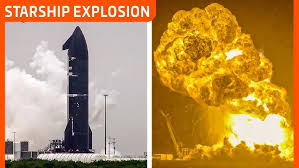SpaceX Starship Explosion: What Happened and What’s Next?

On June 18, 2025, a SpaceX Starship rocket exploded during a test in Texas, sending a massive fireball into the night sky. This event has sparked questions about the rocket’s reliability as SpaceX races to make Starship a key player in space travel. The explosion happened at SpaceX’s Starbase facility, and while no one was hurt, it’s a setback for the company’s big dreams of sending humans to the Moon and Mars. Let’s dive into what happened, why it matters, and what it means for the future of space exploration.
What Happened During the Starship Explosion?
The explosion occurred late Wednesday night at SpaceX’s Massey’s Test Site in South Texas. The rocket, called Ship 36, was being prepared for a static fire test, where engines are fired while the rocket stays anchored to the ground. Suddenly, the rocket burst into flames, creating a huge fireball visible for miles. Videos from groups like NASASpaceflight showed the dramatic moment when the rocket’s nose erupted, followed by a second explosion.
SpaceX confirmed the rocket “experienced a major anomaly” but reported no injuries. Early reports suggest a pressurized nitrogen tank, known as a Composite Overwrapped Pressure Vessel (COPV), may have failed, causing the explosion. The company is now investigating with local and federal officials to understand the cause and ensure safety.
Why This Incident Stands Out
This wasn’t just a small hiccup. The explosion damaged the test site, and it’s unclear how long repairs will take. SpaceX relies on this facility to test Starships before they launch, so the damage could delay future tests. For a company known for its fast-paced development, this is a challenge they’ll need to overcome quickly.
Why Is Starship So Important?
Starship is the biggest and most powerful rocket ever built, standing at 400 feet tall with its Super Heavy booster. SpaceX designed it to carry cargo and people to the Moon, Mars, and beyond. It’s a key part of NASA’s Artemis program, which aims to land astronauts on the Moon by 2027. Elon Musk, SpaceX’s CEO, also sees Starship as the vehicle to make humans a “multi-planetary” species by colonizing Mars.
Key Features of Starship
- Size and Power: It can carry up to 150 tons of cargo, 10 times more than SpaceX’s Falcon 9 rocket.
- Reusability: The rocket is designed to be reused, cutting costs for frequent launches.
- Fuel Innovation: It uses methane, which SpaceX says can be made on Mars for return trips.
A Personal Perspective
I remember watching the first SpaceX Falcon 9 landing in 2015, amazed at how a rocket could return to Earth like a sci-fi movie. Starship takes that vision further, but explosions like this remind us how hard it is to push the boundaries of space. It’s a mix of excitement and frustration, knowing each failure brings us closer to success but at a cost.
A Pattern of Setbacks: Starship’s Rocky Road
This explosion isn’t the first challenge for Starship. In 2025 alone, three test flights ended in failure. In January, a rocket broke apart over the Caribbean. In March, another exploded, causing debris to scatter over Florida. In May, a Starship spun out of control and crashed into the Indian Ocean. Each time, SpaceX called these “rapid unscheduled disassemblies,” a fancy term for explosions.
Comparing Starship’s Test History
| Test Flight | Date | Outcome | Key Issue |
|---|---|---|---|
| Flight 7 | Jan 2025 | Explosion over Caribbean | Liquid oxygen leak |
| Flight 8 | Mar 2025 | Explosion over Florida | Engine failure |
| Flight 9 | May 2025 | Crash in Indian Ocean | Fuel leaks, uncontrolled spin |
| Ship 36 Test | Jun 2025 | Explosion on test stand | Possible nitrogen tank failure |
Why Failures Are Part of the Process
SpaceX follows a “fail fast, learn fast” approach. Unlike traditional space programs that test for years before launching, SpaceX builds and tests quickly, learning from each failure. This method helped them perfect the Falcon 9, now a reliable rocket. However, Starship’s size and complexity make this process riskier. As one X user, @DrChrisCombs, noted, “Starship doesn’t have a fatal flaw, but it’s significantly higher risk in development compared to Falcon 9.”
Challenges Ahead for SpaceX
The explosion raises big questions about Starship’s reliability. NASA is counting on it for the Artemis III mission, and Musk wants it ready for Mars by the late 2020s. But several hurdles remain.
Key Challenges
- Reliability: With multiple explosions, SpaceX must prove Starship can fly safely.
- Orbital Refueling: Starship needs to refuel in space, a complex task never done at this scale.
- Test Site Damage: The Massey’s Test Site is critical for preflight testing, and repairs could cause delays.
Pros and Cons of SpaceX’s Approach
| Pros | Cons |
|---|---|
| Fast development saves time | Frequent failures raise doubts |
| Reusability cuts costs | Complex systems increase risks |
| Bold goals inspire innovation | Delays impact NASA’s timeline |
A Moment of Reflection
I once spoke with an engineer who worked on early rocket designs. He said every failure feels like a punch, but it’s also a lesson. SpaceX’s team must feel that now, knowing each explosion teaches them something new but pushes back their timeline. It’s a tough balance between speed and safety.
What Does This Mean for the Future?
This explosion is a setback, but SpaceX has bounced back before. After a Falcon 9 exploded in 2016, they found the cause—a helium tank failure—and fixed it within months. Musk has already said this explosion was likely due to a nitrogen tank failure, a new issue for this design. The company’s ability to identify and solve problems quickly gives hope for progress.
Looking Ahead
SpaceX plans to launch Starship’s 10th test flight soon, possibly by late July 2025, if repairs move quickly. They’ll need to rebuild the test site and ensure the next rocket, Ship 37, is ready. NASA and Musk’s Mars dreams depend on these tests succeeding. As Musk said on X, “With a test like this, success comes from what we learn.”
Why It Matters to Us
Starship isn’t just about rockets; it’s about humanity’s future in space. A reliable Starship could lower the cost of space travel, making it possible for more countries and companies to explore. It could lead to lunar bases or even cities on Mars. But for now, each explosion reminds us that space is hard, and progress comes with risks.
How SpaceX Can Move Forward
SpaceX’s next steps will be critical. They’ll need to repair the test site, analyze the explosion, and strengthen the nitrogen tank design. They also have to keep NASA and the public confident in their work. The Federal Aviation Administration (FAA), which oversees rocket launches, will likely review this incident before approving more flights.
Steps to Recovery
- Fix the damaged test site to resume static fire tests.
- Investigate the nitrogen tank failure and test new designs.
- Conduct successful test flights to rebuild trust.
A Final Thought
Growing up, I dreamed of seeing humans on Mars, inspired by sci-fi books and movies. SpaceX’s Starship brings that dream closer, but incidents like this show how tough the journey is. Each failure is a step toward success, and SpaceX’s determination keeps the dream alive. For more on Starship’s role in NASA’s plans, check out NASA’s Artemis program or visit SpaceX’s official site for updates on their progress.





